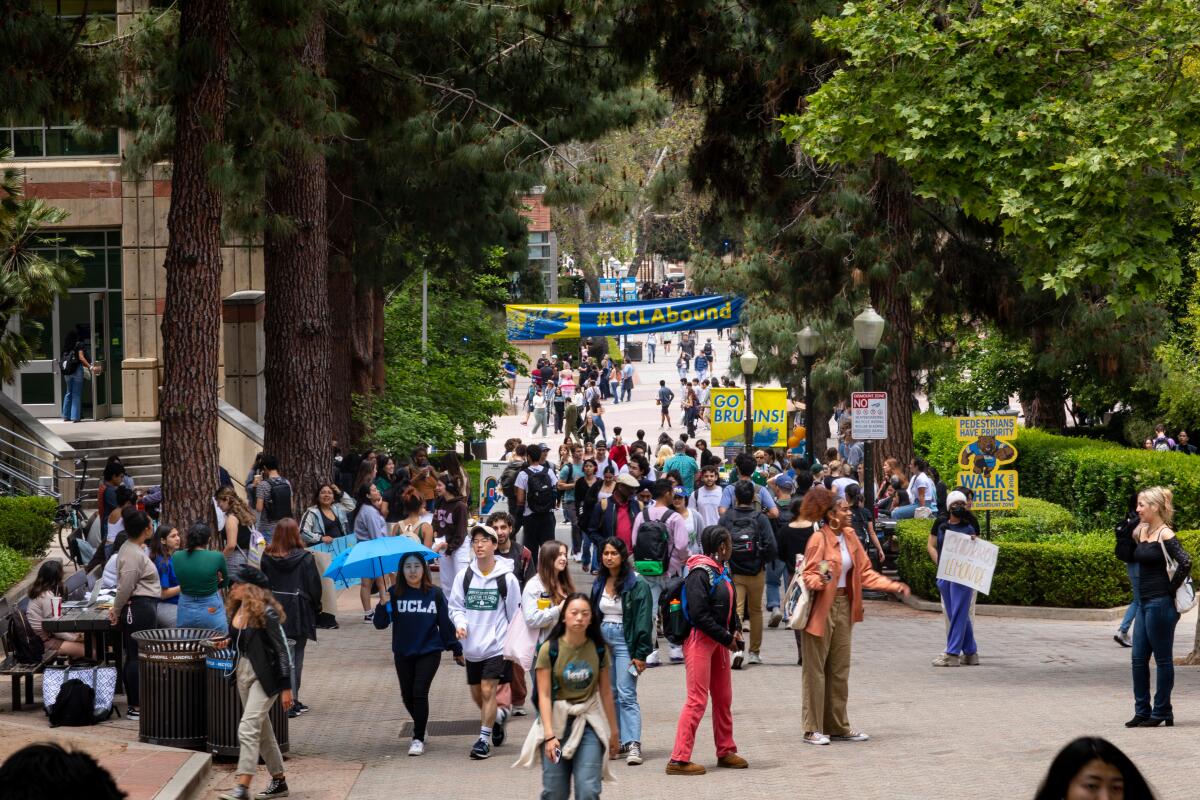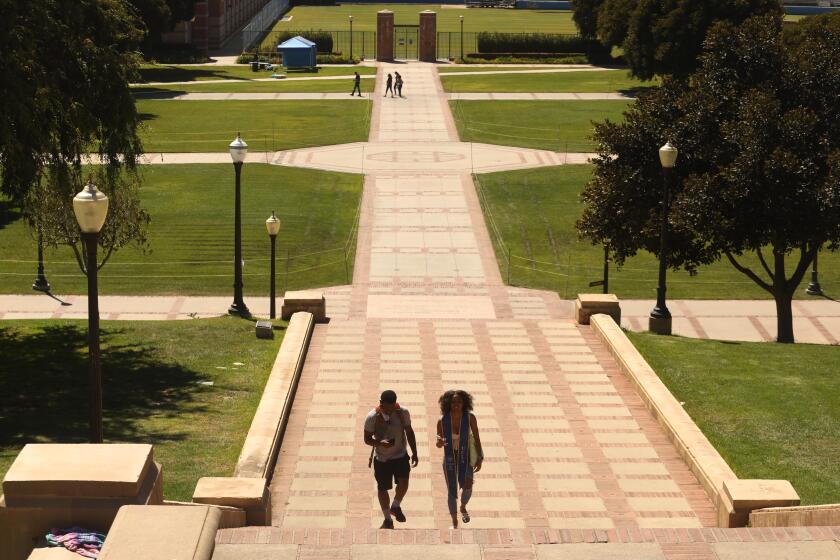UCLA’s fall class bucks trend of diversity decline at elite colleges after affirmative action ban

- UCLA enrolled record numbers of new Black and Latino students for fall 2024, bucking trend of diversity declines at other elite colleges.
- UCLA’s race-neutral recruitment “ground game” builds connections to attract students of color.
- New Bruins of color say they feel welcome and supported by UCLA’s faculty, staff and students who look like them.
Madison Hamilton graduated from Canoga Park Senior High School in spring with multiple accolades: She was high school valedictorian with a 4.5 GPA who aced all eight of her AP tests. She tutored fellow students with special needs and founded a social club for them. And she received a rarefied admission offer from Stanford University, one of the most selective institutions in the nation.
But Hamilton turned Stanford down for UCLA.
She said the Westwood campus’ welcoming environment for Black students like her was the deciding factor. During the spring, for instance, UCLA invited her to campus for an African American Academic Excellence event, where she met Black faculty, including Tracy L. Johnson, dean of the Division of Life Sciences and professor of molecular, cell, and developmental biology.
“Seeing a Black professor who looked like me in a field I wanted to go into really inspired me and made me want to go to UCLA even more,” Hamilton said. “It made me feel like UCLA really wanted me.”

While other elite universities around the nation have seen precipitous declines in diversity in their first class enrolled after the U.S. Supreme Court banned affirmative action, UCLA has bucked that trend with record numbers of Black and Latino students in fall 2024. Like all California public educational institutions, UCLA has been barred from considering race, sex, ethnicity, color or national origin in admissions under Proposition 209, which voters approved in 1996. That forced the university to develop race-neutral policies — and more than 25 years of work on that front is paying off.
UCLA increased its number of Black students by 5.1% and Latinos by 4.3%. Asians and Native Americans stayed about the same, and white students declined by 8.8% among 6,118 first-year students from California and other states enrolled this fall.
UCLA made similar gains for transfer students: The number of Black students increased by 4.5%, Latinos by 5.6% and Asians by 1.5%. Native Americans fell by 28% and whites by 2.8%.
UCLA enrollment greatly differs from other elite schools
Those gains in Black and Latino enrollment contrast sharply with outcomes at other selective institutions in their first post-affirmative-action class. Among 37 top universities and colleges that have posted fall 2024 enrollment data, 30 reported declines in Black students and 23 saw drops in Latino students, according to a tracker by Education Reform Now, a nonpartisan, nonprofit educational organization.
The number of Black students enrolled at Johns Hopkins University, for instance, fell by 66.1% and Latinos by 51.2% in fall 2024 compared with the average during the previous two years. Both demographic groups declined at MIT by 64.3% and 26.7%, respectively, and at Stanford by 37.5% and 11.8% during those same periods.
At Harvard, USC and Pomona College, enrollment of Black students dropped but Latino enrollment increased. Yale and Northwestern, like UCLA, saw increases in both Black and Latino enrollment in their fall class.
“For a lot of these institutions, this past year was a brand new environment” for admissions, said David Hawkins, chief education and policy officer of the National Assn. for College Admission Counseling. “Even though after the Supreme Court’s decision, all colleges and universities reiterated their commitment to equity and access, it can take time to change admission policies because of the sheer diversity of stakeholders that are involved in setting those policies.”
As the Supreme Court weighs affirmative action, the University of California’s struggle with diversity since a 1996 ban offers lessons.
He noted that the vast majority of the nation’s 2,000 four-year colleges and universities have not needed to use affirmative action to parcel out coveted seats because they admit most applicants. His association’s surveys over the years have found that only about 30% of four-year institutions considered race and ethnicity in admissions decisions.
But for colleges and universities newly grappling with how to recruit, admit and enroll diverse students in race-neutral ways, Hawkins said, UCLA offers a useful road map. Two years ago, as the lawsuit against affirmative action programs at Harvard and the University of North Carolina was making its way to the high court, the national college counseling organization invited UCLA to present a primer on how it rebounded from the sharp drop in Black and Latino students triggered by Proposition 209 — and restored diversity with race-neutral efforts.
UCLA recruitment runs deep
The biggest takeaway, Hawkins said, was UCLA’s “ground game.” He praised UCLA’s concerted efforts to build connections with high schools, community organizations and families whose students the university wanted to attract. “They really just very clearly pulled out all of the stops,” he said.
Gary Clark, UCLA associate vice chancellor of enrollment management, said key programs include a collaboration with 28 L.A. Unified high schools, which helps the counselors, principals and district leaders understand early on what rigorous coursework and preparation are needed to prepare their students to be a competitive UCLA applicant.
UCLA, like other University of California campuses, provides direct college counselors — sometimes embedded at the high schools — to supplement the school’s own staff. UCLA campus clubs, such as the Afrikan Student Union, offer welcome events. Campus tours and Bruin Day for all admitted students feature multilingual assistance so parents can receive information in the language they are most comfortable speaking. And UCLA faculty members of diverse backgrounds have become more involved in the recruitment process — helping students like Hamilton see themselves in their success.
Clark also said UCLA has focused on raising money for institutional scholarships to supplement state and federal financial aid, which helps attract underserved students. About 28% of first-year students from California and other states were low-income and 29% were the first in their families to attend college. Among transfer students, 45% were low-income and 41% first-generation.
And partnerships with community colleges have helped UCLA enroll the largest number of transfer students in the UC system. They made up 37% of UCLA’s new class, more than meeting the state’s target of one transfer student for every two first-year students enrolled. Nine out of 10 transfer students were from a California community college.
It took decades to see strong results
Clark said the progress did not come overnight but through “slow and steady” gains.
UCLA’s enrollment of Black students, for instance, plunged after Proposition 209 took effect in 1997 — to 144, or 3% of first-year students in 1998 from 236, or 6%, in 1996. In fall 2024, Black enrollment had increased to 486, or about 8% of first-year students from California and other states.
Latino enrollment dropped to 439, or 10%, in 1998 from 699, or 18%, in 1996. In fall 2024, 1,582 Latinos enrolled, or nearly 26% of first-year students.
Asians were the largest group at 39% of the fall 2024 first-year class, with whites at 22% and Native Americans 1%.
Clark credited his team’s hard work for the gains in diversity this year, but he also gave a shout out to the new students, who had to navigate through major snafus in the federal financial aid application process as college applicants last year.
“You’ve got to give credit to these students and their families for the resilience that they showed,” Clark said.
Luis Barbosa never gave up on his dream to attend UCLA — even after he was rejected as a first-year applicant two years ago. He said he fell into a deep depression and began resenting his first-generation status, blaming his Mexican immigrant parents for not better educating him on how to be a competitive college applicant.
But a counselor at Segerstrom High School in Santa Ana told him he could take the community college route to UCLA. He enrolled at Irvine Valley College. There, he overcame his fears and learned to approach counselors and faculty for help. He stayed on top of courses needed for UCLA and sought tutoring to help transform his grades from Bs and Cs in high school to A’s in community college. He took on leadership roles as a mentor to younger students, an officer in the honor society and a campus ambassador to promote higher education.
“I was really in a dark place, but I constantly told myself I can either let fear be my future or I will let fear be my motivation to drive me to do things to get to UCLA,” Barbosa said.

America Jimenez is also the daughter of Mexican immigrants — her father is a truck driver and her mother works at a flea market. She dared not dream of attending UCLA because she feared rejection. But with her 4.5 GPA from Aspire Pacific Academy in Huntington Park, leadership roles in student government and maturity she developed from taking care of her younger sister — even on exam nights — when her parents were at work, Jimenez got the admission offer from UCLA. She and her mother both cried with joy.
Jimenez said she has found a welcoming community at UCLA, with roommates of similar Latina backgrounds and involvement with Hermanas Unidas, a campus group that provides support and resources for Chicana and Latina women.
Hamilton said the Black Bruin Resource Center gives her a sense of belonging as she thinks about the Black pioneers who walked the campus before her, such as baseball legend Jackie Robinson and Ralph Bunche, a civil rights icon who was the first African American awarded the Nobel Peace Prize. Her father also graduated from UCLA with a political science degree.
At the same time, she said, she was thrilled to attend a university with students of so many other backgrounds, a departure from Canoga Park High, whose students are 87% Latino.
“As a Black student, I love being around people who look like me, but I also get joy being with people who don’t look like me,” she said. “I’m grateful I can be at such an integrated campus. Everyone here is so supportive and I feel they believe in me.”
More to Read
Sign up for Essential California
The most important California stories and recommendations in your inbox every morning.
You may occasionally receive promotional content from the Los Angeles Times.












